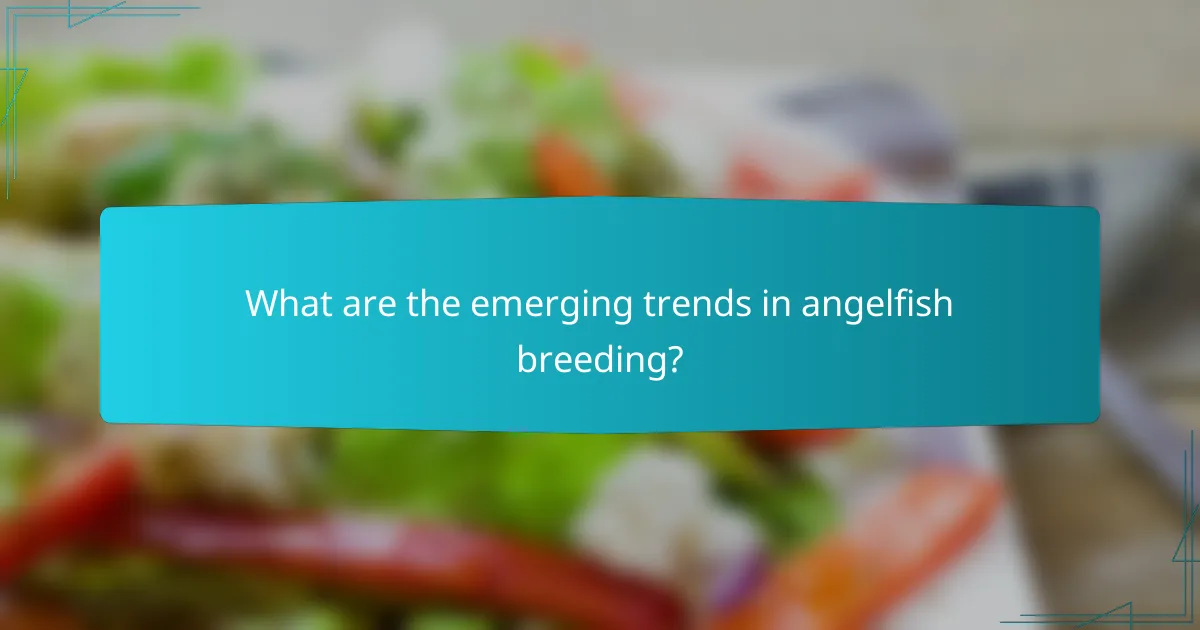Angelfish thrive best in tanks that are at least 20 inches tall, allowing them ample swimming space and promoting healthy behavior. Breeding these fish requires careful attention to their specific needs and creating an optimal environment for successful reproduction. Additionally, selecting compatible species for a community tank is crucial, as peaceful and similarly sized tank mates help maintain a harmonious ecosystem.

What is the ideal tank height for angelfish?
The ideal tank height for angelfish is at least 20 inches, as this provides ample swimming space and promotes healthy behavior. A taller tank allows angelfish to exhibit their natural swimming patterns and reduces stress, especially during breeding.
Minimum height of 20 inches
A minimum tank height of 20 inches is crucial for angelfish to thrive. This height accommodates their vertical swimming habits and helps prevent territorial disputes. Tanks shorter than this may restrict movement, leading to stress and aggression among the fish.
When setting up a tank, consider the overall volume as well. A tank that is both tall and adequately wide will provide a more stable environment, which is beneficial for the fish’s health.
Recommended height for breeding
For breeding angelfish, a tank height of 24 inches or more is recommended. This additional height allows for better water quality management and provides a more suitable environment for the breeding process. Angelfish tend to prefer taller tanks during breeding as they can establish territories more effectively.
In a breeding setup, ensure that the tank has sufficient hiding spots and flat surfaces for egg laying. This will help reduce stress and increase the chances of successful spawning.
Impact of tank height on angelfish behavior
The height of the tank significantly influences angelfish behavior. Taller tanks encourage natural swimming patterns and reduce stress levels, which can lead to healthier fish. In contrast, shorter tanks may result in increased aggression and territorial disputes.
Moreover, angelfish are known to exhibit more vibrant colors and active behaviors in appropriately sized tanks. Providing a suitable height can enhance their overall well-being and longevity, making it essential for any angelfish keeper to consider tank dimensions carefully.

How to breed angelfish successfully?
Breeding angelfish requires specific conditions and careful attention to their needs. Creating the right environment and providing proper care during the breeding process are essential for successful reproduction.
Breeding conditions and tank setup
To breed angelfish, set up a dedicated breeding tank with a height of at least 45-60 cm (18-24 inches) to allow for vertical swimming space. Use a soft substrate and include flat surfaces like broad-leaved plants or spawning cones where the fish can lay their eggs.
Maintain stable water parameters, aiming for a temperature between 26-30°C (79-86°F) and a pH level of around 6.5-7.5. Regular water changes are crucial to keep the environment clean and conducive for breeding.
Feeding during breeding
During the breeding period, provide a high-quality diet rich in protein to enhance the health of the angelfish. Options include live or frozen foods such as brine shrimp, bloodworms, and high-quality flakes or pellets designed for breeding fish.
Feed them multiple small meals throughout the day rather than one large feeding to ensure they receive adequate nutrition without polluting the water. This approach promotes better breeding readiness and overall vitality.
Egg care and hatching process
Once the female lays eggs, the parents will typically guard and aerate them. It’s important to avoid disturbing the breeding pair during this time. The eggs usually hatch within 48-72 hours, depending on the water temperature.
After hatching, the fry will remain attached to the spawning surface for a few days before becoming free-swimming. At this stage, provide infusoria or finely crushed flakes to feed the tiny fry, ensuring they receive the necessary nutrients for growth.

Which species are compatible with angelfish?
Angelfish can thrive in a community tank with the right compatible species. Ideal tank mates should be peaceful, of similar size, and not overly aggressive to ensure a harmonious environment.
Best tank mates for angelfish
Some of the best tank mates for angelfish include tetras, gouramis, and certain types of catfish. Species like neon tetras and rasboras are small and peaceful, making them suitable companions. Additionally, larger cichlids, such as keyhole cichlids, can coexist well if introduced properly.
Species to avoid with angelfish
It is crucial to avoid aggressive or overly territorial species when keeping angelfish. Fish like bettas, some barbs, and large cichlids can pose a threat due to their aggressive behavior. Additionally, small fish that may be seen as food, such as guppies, should be kept out of the tank.
Compatibility based on tank size
The size of the tank significantly influences compatibility with angelfish. A minimum tank size of 20 gallons is recommended for a small group of angelfish and their companions. In larger tanks, such as those over 50 gallons, a wider variety of species can be introduced, allowing for a more diverse community.

What are the key care requirements for angelfish?
Angelfish require specific care to thrive, including appropriate tank conditions, diet, and health management. Understanding their needs will help ensure a healthy and vibrant aquarium environment.
Water quality and temperature
Maintaining optimal water quality is crucial for angelfish. They thrive in soft to moderately hard water with a pH range of 6.5 to 7.5. The temperature should be kept between 24°C and 28°C (75°F to 82°F) to promote healthy growth and breeding.
Regular water changes, ideally 25% every two weeks, help maintain water quality. Use a reliable filtration system to keep ammonia and nitrite levels at zero, and nitrate levels below 20 mg/L.
Feeding guidelines for angelfish
Angelfish are omnivorous and benefit from a varied diet. A balanced diet should include high-quality flake food, pellets, and occasional live or frozen foods like brine shrimp or bloodworms. Feed them 2-3 times a day, providing only what they can consume in a few minutes.
Avoid overfeeding, as this can lead to health issues and water quality problems. Monitor their eating habits and adjust portions accordingly to maintain their health and prevent waste buildup in the tank.
Common health issues and treatments
Angelfish can be susceptible to several health issues, including ich, fin rot, and swim bladder disease. Ich presents as white spots on the body, while fin rot appears as frayed or discolored fins. Early detection is key for effective treatment.
For ich, raising the water temperature and adding aquarium salt can help. Fin rot may require improved water quality and antibiotic treatment. Always quarantine new fish to prevent the introduction of diseases into your main tank.

What factors influence angelfish tank setup?
Several key factors influence the setup of an angelfish tank, including tank height, decor, filtration, and water circulation. Proper attention to these elements ensures a healthy environment for angelfish, promoting their well-being and longevity.
Decor and hiding spots
Angelfish thrive in environments that mimic their natural habitat, which includes plenty of decor and hiding spots. Use tall plants, driftwood, and rocks to create vertical space and shelter, as angelfish enjoy exploring and hiding.
When selecting decor, ensure that it is safe for aquariums and won’t leach harmful substances. Avoid sharp edges that could injure the fish, and consider using live plants, which can also help maintain water quality.
Filtration and water circulation
Effective filtration and water circulation are crucial for maintaining a clean and healthy tank for angelfish. A good quality filter should provide mechanical, biological, and chemical filtration to keep the water clear and free from toxins.
Angelfish prefer moderate water flow, so choose a filter that can handle the tank size without creating excessive current. Regular maintenance, including changing filter media and cleaning the tank, will help ensure optimal water conditions.

What are the emerging trends in angelfish breeding?
Emerging trends in angelfish breeding focus on hybridization, color variations, and improved breeding techniques. Breeders are increasingly experimenting with crossbreeding to create unique varieties that appeal to aquarists and enhance genetic diversity.
Hybrid angelfish varieties
Hybrid angelfish varieties are created by crossing different species or color morphs of angelfish. This practice results in unique appearances and traits, such as enhanced coloration or size. Popular hybrids include the koi angelfish, which features a striking orange and white pattern, and the marble angelfish, known for its swirling color patterns.
When breeding hybrids, it is essential to consider the genetic compatibility of the parent species to ensure healthy offspring. Breeders should also be aware of potential health issues that may arise from hybridization, such as susceptibility to diseases or deformities.
Breeding care for angelfish
Proper breeding care for angelfish involves maintaining optimal water conditions, including temperature, pH, and hardness. A temperature range of 78-82°F (25-28°C) is ideal, while a slightly acidic to neutral pH (6.5-7.5) is recommended. Regular water changes and filtration are crucial to keep the environment healthy for breeding.
Providing suitable spawning sites, such as flat surfaces or plants, encourages angelfish to lay eggs. After spawning, it is important to monitor the eggs and fry closely, as they require specific care, including appropriate food and protection from potential predators.
Compatible species for angelfish tanks
When selecting compatible species for angelfish tanks, consider fish that share similar water requirements and temperaments. Suitable tank mates include tetras, gouramis, and some types of catfish. Avoid aggressive species, as they can stress angelfish and disrupt their breeding.
It is advisable to maintain a tank size of at least 55 gallons to provide ample space for angelfish and their companions. This helps reduce territorial disputes and allows for a more harmonious community tank environment.










